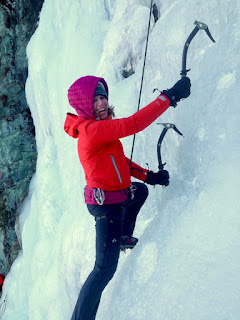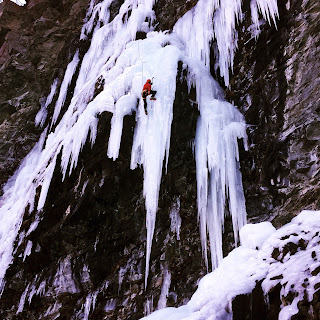Spearheading this annual event is no easy task – fluctuations in weather, coordinating ice-themed movies and gathering an array of inspirational speakers, and promoting the event (in 4 languages!) is a challenge in itself! For the fifth consecutive year, professional ice climbers Matthias Scherer, Tanja and Heike Schmitt met the challenge with gusto. Leveraging their creativity, huge talents and a contagious passion for the many disciplines of climbing, an array of nationalities from Finland to Canada to Holland to England took the opportunity to embrace and refine ice climbing, mixed climbing and dry-tooling skills.
The festival, one of the first key social events of the winter in Cogne, is an opportunity to learn, have fun, meet new people and share experiences. The event is sponsored by Arc’teryx, Black Diamond, La Sportiva, Petzl, and Sterling Rope, who are all on-hand to answer questions, sharpen tools and ensure that even if you were to show up in a pair of Bermuda shorts you could be fully kitted out, cramponed up and climbing up a frozen waterfall in about 10 minutes.
The first sip of hot mulled-wine (Italian style) in the bar at the ‘Apero’ on Friday evening indicated that the festival had well and truly begun – the atmosphere was already buzzing and a growing group of participants were chatting about the options available given this seasons already mixed conditions. This is my fourth consecutive year attending the festival. One of the highlights for me is seeing so many familiar faces – many met whilst hanging off the ice last year!
Early on Saturday morning, under a clear crisp sky and temperatures hovering well below zero, participants broke out into their climbing groups, led under the watchful eyes of guides from Italy, France, Switzerland and Poland. Led by our guides Heike and Isabelle, our group began the trek up to the ridgeline to a route which would not only challenge us but also provide a safe learning ground for new skills. The trek was invigorating and proved to be a wonderful opportunity to warm up our muscles whilst meeting new people and sharing previous climbing (and life!) experiences.
Isabelle Santoire and Heike Schmitt shared their experience and insights with us. There was a strong focus on safety and skills balanced in equal measure with a sense of fun.
About 5 hours later, the laughs, pumped arms, tingling toes and rosy cheeks were evidence of our brilliant day out. I learned and practised new techniques and certainly gave my arms a workout. By around 3pm with chilled fingers and toes we all began to head down to the bar for liquid refreshments and the opportunity to share stories with other groups coming back from their own adventures.
That evening we headed into the quaint town of Cogne for an ‘All about the Ice’ movie night. With bellies full of Italy’s finest pizza, we sat back in the theatre to be inspired… and were not disappointed. With presentations from athletes and films from extreme climbers including Rudi Hauser, as well as the inspirational Heike and Tanja Schmitt and Matthias Scherer we quickly realised the tremendous dedication, passion and commitment required in climbing – or any sport for that matter.
 Sunday presented us with an equally stunning blue-sky and crisp clear conditions. Under the watchful eye of our guides for the day, Nicholas and also Jon Bracey, we headed up to a more advanced route. I was a bit nervous as the degree of difficulty was a significant step up from the previous day but aided by a solid top rope and a group of supportive ‘cheerleaders’ it was a perfect training ground. You don’t feel ego here and it quickly became clear that I was in the company of some very experienced climbers, yet the set-up had something for all levels. We jumped in when somebody needed a belay, encouragements were shouted, and we learned from each other. It was clear from the outset that the routes tested our abilities and we all came away from the day with a tremendous sense of satisfaction and a desire to continue pushing ourselves to the next level.
Sunday presented us with an equally stunning blue-sky and crisp clear conditions. Under the watchful eye of our guides for the day, Nicholas and also Jon Bracey, we headed up to a more advanced route. I was a bit nervous as the degree of difficulty was a significant step up from the previous day but aided by a solid top rope and a group of supportive ‘cheerleaders’ it was a perfect training ground. You don’t feel ego here and it quickly became clear that I was in the company of some very experienced climbers, yet the set-up had something for all levels. We jumped in when somebody needed a belay, encouragements were shouted, and we learned from each other. It was clear from the outset that the routes tested our abilities and we all came away from the day with a tremendous sense of satisfaction and a desire to continue pushing ourselves to the next level. It was a brilliant weekend. Piling into my Swiss Air flight back to London that evening I’d already begun planning my next trip to Cogne as well as additional winter adventures.
The annual Cogne Ice Festival welcomes people of all abilities and tailors the sessions around your level of experience and what you want to get out of it. If you're intrigued by the sport of ice climbing and want to have a go, there are a number of options available:
- Try it out at one of the UK’s indoor walls: Vertical Chill in Ellis Brigham Covent Garden, (London) or Ice Factor (Europe’s biggest indoor ice climbing wall) in Fort William, Scotland
- Check out www.mountainwomen.net to learn ice climbing in small groups
- Sign up for an introductory course in the Alps or in Scotland. Rijukan, Norway is very popular for ice climbing too
- Hire a private guide, such as Heike Schmitt, Jonathan Bracey, or Isabelle Santoire (all based between Chamonix, France and Cogne, Italy) to show you the ropes for a day or two. For an action packed weekend, combine this with a skiing trip in the Alps!
Huge thanks to Matthias, Tanja, and Heike for organising the event, for your creativity and for sharing your passion with us..! Thanks also to the event sponsors Arc’teryx, Black Diamond, Petzl, La Sportiva, Sterling Rope and to all the guides involved for supporting the festival and helping to open up this icy world... See you next year!!



























































